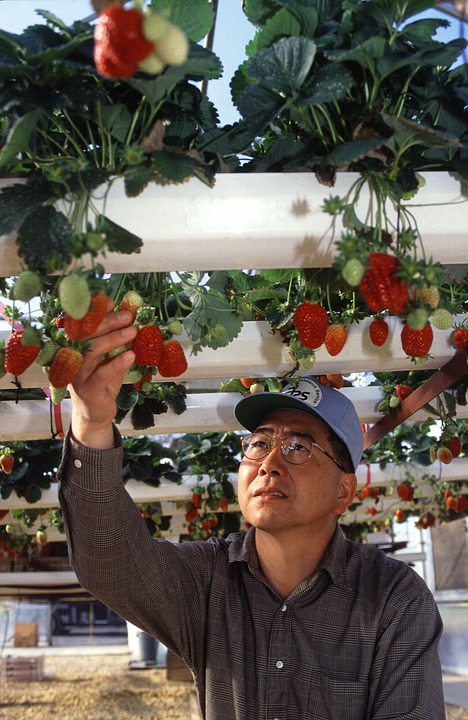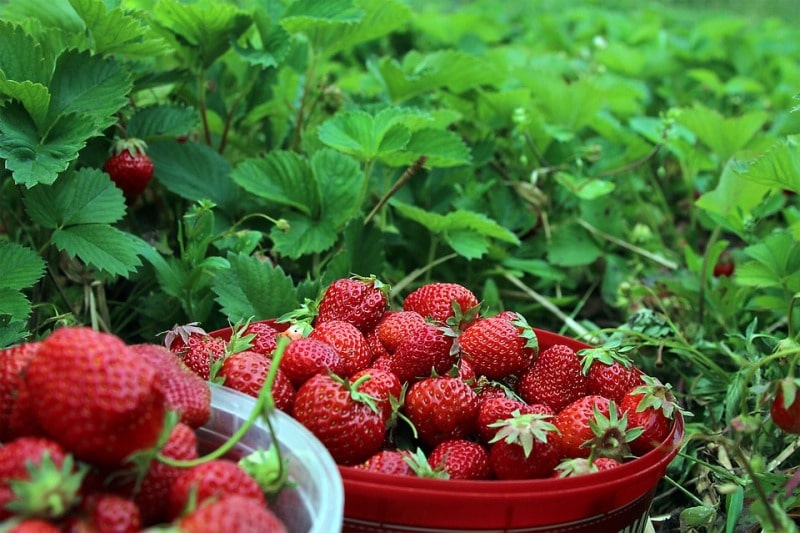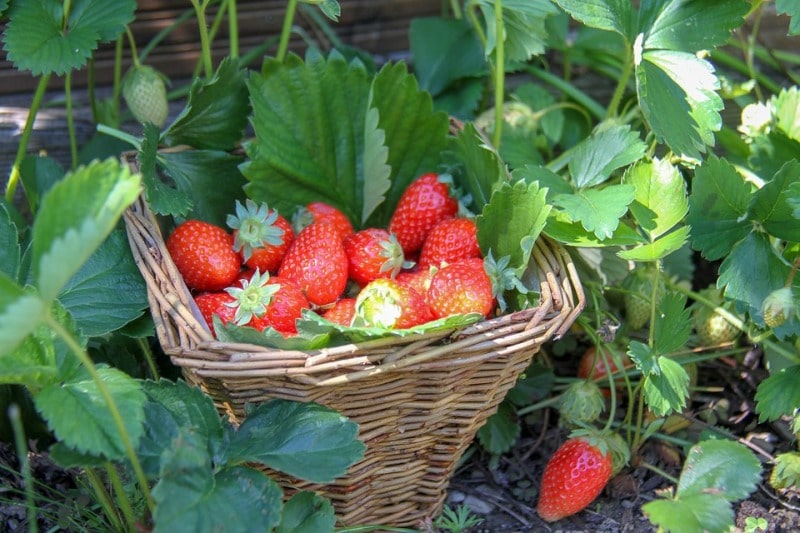Hydroponic Strawberry Gardening Techniques
Today, the topic is about hydroponic strawberry gardening tips and techniques. How to grow hydroponic strawberries? With time, everything is touch by hands of modernization and the quality and productivity of every aspect of life have been changed. So is our primitive ways of gardening. We used to saw fields, water them regularly, manuring and weeding at proper intervals of time. Now we don’t even need soil the rudimentary thing that is soil. We moved onto a much conservative solution, saving us from the hustle of maintaining soil pH and all the other extra work that tagged along the process.

So, today we will be discussing the process of growing strawberries hydroponically. Strawberries belong to the Rose family (Rosaceae, genus Fragaria) that includes many of the other fragrant and flavorful species of pears, plums, cherries, and apples. At first, the succulent berries were termed strew-berries because of the runners and berries grew across the ground. However, the name strawberry gradually evolved with time. Strawberries thrive in hydroponic grow systems and can produce large amounts of fresh fruit all through the year.
A hydroponic system is not that much tricky and can be easily achieved by keeping in mind some basic needs like proper watering and maintaining the nutrient levels of the water so as to produce plump, juicy, unblemished strawberries. The best thing about this style of gardening is that production is not affected by the season as a hydroponic system can be established outdoors or indoors and that too with the help of artificial light.
Types of Strawberries and varieties recommended for hydroponics:
Strawberries can be categorized in the following classes depending upon the growing seasons and requirement for the light.
Read: How to Grow Hydroponic Strawberries.
June-bearing strawberry:
June bearers are the most popular one because of the time period they take to grow that is of two to three weeks, on average. Most of the June bearing strawberry varieties ripe and are harvested around the month of June, and the, therefore, got its name. Strawberry varieties can be further defined under the category of the early season, midseason, and late season. When we select different varieties that can be produced during different parts of the season, we can prolong the harvest for a longer period of time. June bearing strawberries are (Fragariax ananassa) the Garden Strawberry variety. These are preferred to be grown using the matted row system.
Everbearing strawberry varieties:
As the name would you give some idea but they are not everbearing. They usually have a rate of two harvests per year production: one in the spring and another in the late summer or maybe fall. Basically grown in the hills the everbearing strawberries are often planted in locations where space is limited. If we are talking about the ideal conditions, it is may be possible for
Some everbearing varieties to produce even three harvests. Most of the everbearing strawberry types are also hybrids of Fragariax ananassa, but some may be of the species Fragaria vesca. So in layman term, we can say that everbearing varieties grow out fewer runners than the hybrids of June bearing varieties, the concept is to produce maximum yields by converting the energy into produce.
Some everbearing varieties are:
Ozark Beauty, Ft. Laramie
Day-neutral strawberry varieties:
Day-neutral varieties will give better yield in the first year of the plantation. 35 and 85 degrees is the ideal temperature to set flowers into fruits, and they keep on producing fruit in October during milder years. The only drawback to a day-neutral variety of strawberry plants is that they strawberries are smaller in size than the June bearing and the everbearing strawberry varieties. Fruit usually ranges from small to medium in size, and can rarely exceed one inch. Plants from these varieties are often planted following the hill system or are grown in the locations where space is limited as such.
Some day-neutral varieties are:
Mara de bois, Tribute, Albion, Quinault, Seascape
When can we do the plantation?

Now that we have discussed the varieties of strawberries and their gardening aspects we can move onto the method, as such how are we supposed to produce and maintain the hydroponic plantation. One of the major advantages is in hydroponics; there are no strict growing season requirements. Your growing season will be chiefly affected by the availability of runners, either in stores or in your outdoor gardens. Starting with strawberry growing season there is no such rule that when we can grow the plants in hydroponics, it is easy to get appropriate nutrient mixes for specific plants from your local store. Like any other plant strawberries also require both essential nutrients: Nitrogen, Potassium, and Phosphorus (NPK) are essential for basic plant survival. Nitrogen promotes cell growth, phosphorus is helpful for the roots, flowers, and buds, and potassium is required for the process of photosynthesis and trace elements: Iron, manganese, zinc, copper, molybdenum, cobalt, and chlorine, among others. In case of lack of these elements will result in poor plant growth.
Most hydroponics nutrient mixes contain these trace elements in the water as there is no need to have the support of soil in hydroponics. If you are using a nutrient mix intended for the proper.
Read: Greenhouse Types and Building Greenhouse.
In hydroponics, we don’t have to worry about anything like a nutrient deficiency. Hydroponic strawberry can grow throughout the season if runners from home ground plants are given the required cold stimulation. One week after propagating strawberry hydroponically we can have good produce throughout the year this can be achieved by placing the strawberries in the refrigerator for a time period 6 to 12 weeks.
Temperature requirement
Now talking about the ideal temperature requirement these plants require a temperature that can vary from cool to warm we can say that the ideal temperature should be somewhere between 60 to 80 degrees Fahrenheit or 15 to 27 degrees Celsius. According to experienced hydroponic growers, the night temperature results in increased fruit and the temperature should be between 10 to 12 degrees. Strawberry can be stored for a longer period of time as the plant preferred hibernation period of 2 to 5 months in winters.
Pollination
Strawberries are self-fertile and pollinate themselves without any external aid but pollination is a key concern. Strawberry plants are monoecious that is both the male and female parts on the same plant but require help from pollinating agents such as wind, bees, or someone to help transfer the pollen. To help with pollination indoor it simply requires brushing the open flowers with hand or to each other for the transfer of the pollen from the stamens onto the pistils.
Light duration
Strawberries are most preferably either short day or day neutral. This means that they can manage their growth with shorter light durations. Anywhere between 8-12 hours of proper light is usually more than enough for proper growth and good yield. It doesn’t require varying the light schedule in different stages either.
Strawberry nutrient solution:
In hydroponics, it is easy to get appropriate strawberry nutrient solution easily for growing plants from your local store and various online sites selling horticultural implements, hydroponic kits, and solutions. Like any other plant strawberries also require both essential nutrients: Nitrogen, Potassium, and Phosphorus (NPK) are essential for basic plant survival. Nitrogen promotes cell growth, phosphorus is helpful for the roots, flowers, and buds, and potassium is required for the process of photosynthesis and trace elements: Iron, manganese, zinc, copper, molybdenum, cobalt, and chlorine, among others. In case of lack of these elements will result in poor plant growth.
The most hydroponic strawberry formula contains these trace elements in the water as there is no need to have the support of soil in hydroponics. If you are using a nutrient mix intended for the proper hydroponics, we don’t have to worry about anything like a nutrient deficiency. One question may arise are strawberries organic? And yes it can be possible with hydroponics strawberry gardening as you can manage the nutrients and growing environment yourselves and when you are keeping it free from chemicals it becomes organic.
Disease management of hydroponic strawberry gardening
Though soil-borne diseases are virtually eliminated by opting hydroponics gardening. But in hydroponics rotting of the roots can sometimes be a bigger problem. There are some chemicals in the market that can help plants to combat Pythium root rot. It can work to strengthen plants roots against root rot. So, we would suggest managing that in case. Important caution to avoid disease is to not allow water to be stagnated in your hydroponic system as standing water causes low oxygen conditions which promote fungal growth. And best practice is to start gardening with healthy planting materials.
pH Levels for hydroponic strawberry gardening
The optimal pH level for the nutrient solution when growing strawberries is generally in the range of 5.8 – 6.2. The accumulation of mineral salts can adversely affect strawberry growth. The pH level of the nutrient solution can always be manipulated by either adding potassium hydroxide (so as to increase pH), or phosphoric acid (so as to decrease pH).In hydroponics, the nutrient mixes containing minerals sometimes can affect the water electrical conductivity levels.
Read: How to Grow Organic Chilli in the Container.
Plantation material for hydroponic strawberry gardening
Like other crops, Strawberry seeds can also be used for raising strawberry plants. But if you are opting for hydroponics system for cultivating strawberry plants then the seed is not the right choice. Strawberry plants grown from seeds take time to mature maybe over 2 to 3 years. And when you are planning to enjoy fresh and juicy fruits this year then this option is out of the question again. Runners are the best material for propagating strawberries, especially in soil-less culture. Some stems instead of growing vertically grow horizontally. These stems have the capability to sprout roots and thus gives a rose to a new plant. Such stems are harvested from the mature strawberry plants and are allowed to grow. Runners can easily be obtained from local nurseries or gardening stores.
Hydroponic strawberry gardening guide

As far as hydroponics is concerned strawberries are incredibly versatile. The reason behind this is mainly due to their small root systems.
Runners can be grown by a wide variety of techniques; they can range from simple to quite complex methods and that to mobile to more complex and stationary growing systems. They include:
- Deep Water Culture
- Aeroponics
- Ebb & Flow
- Wick system
- Nutrient Film Technique
We can choose the plantation system of strawberries by using hydroponics commercially i.e growing hydroponic strawberries for profit or as hobby growers any one of these different techniques. Deep water culture (DWC) strawberries gardening system is most useful if you have space to grow a large number of plants that too in a single-tiered system. Others are much more suitable for compact multi-tiered growth systems. As a result, commercial and hobby growers prefer any one of these different techniques.
First, determine which hydroponic gardening method will be suitable for the location you are and a number of plants you want to plant. If you are opting for smaller, multi-tiered deep water culture, drip irrigation garden or Nutrient Film Technique (NFT) is preferred as the method of choice for both the purpose of hobby and commercial growers. Plants can be cultivated at high density in PVC pipes hence giving you an opportunity to DIY hydroponic strawberry gardening setup. The only point to be considered is that strawberries will hang down, so space should be maintained between each plant for this to happen freely.
Flood and drain or EBB and flow works well if you are looking for production for a large number of plants, however, the only drawback is once established it cannot be made mobile on preference. One of the famous hydroponic systems for growing strawberry is, hydroponics strawberries Kratky its complete setup along with installation guidelines are easily available in a number of online sites.
The process starts with careful removal of the runners or the new strawberry plant from its potted container. After that, we remove as much of the soil as we can by gently shaking or massaging the roots gently.
Then submerge the entire root system in a container of cold water for approximately for 10 minutes then we rinse roots under cold running water to remove all the remaining soil and dirt. This process is called chilling treatment. Chilling is important for a strawberry to start its growth cycle, if chilling treatment is not done properly then plants may not showcase their full vigour.
One has to be very careful because any root breakage will seriously increase the stress in plants and can lead to impaired growth.
Then prepare the growing medium by soaking it in pH balanced water for 30 minutes.the grwoing medium used must be well drained and aerated. Avoid using coco peat, rather use a combination of perlite – vermiculite or coco coir mixed with perlite or vermiculite. Now fill the container with the growing medium, up to two-thirds level. For growing container, you can use either individual pots or a single large tub. Ensure that growing containers can rest securely upon the reservoir.
Then fill the reservoir with a mix of water and nutrients solution. The reservoir can be of any material as long as it can hold water. You can use small or large container depending upon the number of plants to be raised. A reservoir of about 5 gallons is quite large to harvest a good amount of strawberries.
Now securely place the grow container over the reservoir. Again you will have to place the strawberry plant inside these containers and have to spread the roots evenly into the prepared growing medium.
Now cover the roots with more growing medium and but never cover the crown of the plant as the crown requires light and fresh air because this is where new leaves and flowers will grow. If we submerge the crown, it will rot and cause the entire plant to die.
Check the reservoir daily for water levels. Refill the container when the level gets low is critical for the survival of the plants. Keep a close watch on the pH levels and EC levels when refilling the container with a fresh nutrient water mix.
Now all there is to keep in mind that you have to flush the growing medium using fresh water once per week and that we remove accumulated mineral salts. Four weeks is generally the maximum time between flushing.
Place the strawberries under sunlight if we are growing plants as outdoor hydroponics. In case of indoor gardening, use grow lights and ensure that the plants get adequate light.
Another thing that we have to keep in mind is that harvest fruits only when they are completely ripped and turn red in color because as most of you may not be aware of the fact but unlike other fruits, strawberries do not ripen once plucked. Now you can clip additional runners from adult plants if wanted we can grow more strawberries all through the year.
That’s all folks about hydroponic strawberry gardening techniques, tips and methods.
Read: Kaju Cultivation Tips, Techniques.